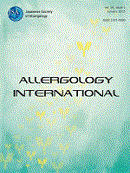Volume 65, Issue 1
Displaying 1-21 of 21 articles from this issue
- |<
- <
- 1
- >
- >|
EDITORIAL
-
2016 Volume 65 Issue 1 Pages 1-2
Published: 2016
Released on J-STAGE: January 29, 2016
Download PDF (184K)
INVITED REVIEW ARTICLE
Review Series: Anaphylaxis - two stories not covered by the current guidelines
-
2016 Volume 65 Issue 1 Pages 3-15
Published: 2016
Released on J-STAGE: January 29, 2016
Download PDF (1903K) -
2016 Volume 65 Issue 1 Pages 16-20
Published: 2016
Released on J-STAGE: January 29, 2016
Download PDF (521K)
REVIEW ARTICLE
-
2016 Volume 65 Issue 1 Pages 21-29
Published: 2016
Released on J-STAGE: January 29, 2016
Download PDF (1776K) -
2016 Volume 65 Issue 1 Pages 30-36
Published: 2016
Released on J-STAGE: January 29, 2016
Download PDF (409K)
ORIGINAL ARTICLE
-
2016 Volume 65 Issue 1 Pages 37-43
Published: 2016
Released on J-STAGE: January 29, 2016
Download PDF (2736K) -
2016 Volume 65 Issue 1 Pages 44-51
Published: 2016
Released on J-STAGE: January 29, 2016
Download PDF (1951K) -
2016 Volume 65 Issue 1 Pages 52-55
Published: 2016
Released on J-STAGE: January 29, 2016
Download PDF (209K) -
2016 Volume 65 Issue 1 Pages 56-61
Published: 2016
Released on J-STAGE: January 29, 2016
Download PDF (533K) -
2016 Volume 65 Issue 1 Pages 62-67
Published: 2016
Released on J-STAGE: January 29, 2016
Download PDF (1078K) -
2016 Volume 65 Issue 1 Pages 68-73
Published: 2016
Released on J-STAGE: January 29, 2016
Download PDF (663K) -
2016 Volume 65 Issue 1 Pages 74-81
Published: 2016
Released on J-STAGE: January 29, 2016
Download PDF (422K) -
2016 Volume 65 Issue 1 Pages 82-87
Published: 2016
Released on J-STAGE: January 29, 2016
Download PDF (346K) -
2016 Volume 65 Issue 1 Pages 88-95
Published: 2016
Released on J-STAGE: January 29, 2016
Download PDF (880K) -
2016 Volume 65 Issue 1 Pages 96-102
Published: 2016
Released on J-STAGE: January 29, 2016
Download PDF (959K) -
2016 Volume 65 Issue 1 Pages 103-108
Published: 2016
Released on J-STAGE: January 29, 2016
Download PDF (498K)
LETTER TO THE EDITOR
-
2016 Volume 65 Issue 1 Pages 109-111
Published: 2016
Released on J-STAGE: January 29, 2016
Download PDF (260K) -
2016 Volume 65 Issue 1 Pages 112-114
Published: 2016
Released on J-STAGE: January 29, 2016
Download PDF (537K) -
2016 Volume 65 Issue 1 Pages 115-116
Published: 2016
Released on J-STAGE: January 29, 2016
Download PDF (185K) -
2016 Volume 65 Issue 1 Pages 117-119
Published: 2016
Released on J-STAGE: January 29, 2016
Download PDF (255K)
CORRIGENDUM
-
2016 Volume 65 Issue 1 Pages 120
Published: 2016
Released on J-STAGE: January 29, 2016
Download PDF (154K)
- |<
- <
- 1
- >
- >|
